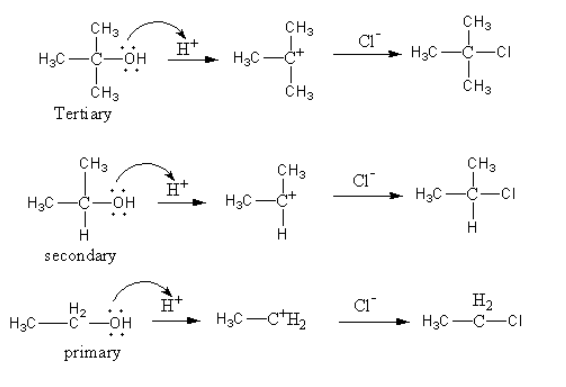
An unknown alcohol is treated with the “Lucas reagent” to determine whether the alcohol is primary, secondary or tertiary. Which alcohol reacts fastest and by which mechanism?
A. Tertiary alcohol by ${{\text{S}}_{\text{N}}}{\text{2}}$
B. Secondary alcohol by ${{\text{S}}_{\text{N}}}1$
C. Tertiary alcohol by ${{\text{S}}_{\text{N}}}1$
D. Secondary alcohol by ${{\text{S}}_{\text{N}}}{\text{2}}$
Answer
463.5k+ views
Hint: The reaction of an alcohol with Lucas reagent takes place in two steps. In the first step carbocation forms and in the second step product alkyl chloride forms. The Lucas reagent differentiates the alcohol, on the basis of their reactivity or the stability of the intermediate.
Complete Step by step answer: Lucas test is used to distinguish the primary, secondary and tertiary alcohols. The mixture of concentrated hydrochloric acid and dry anhydrous zinc chloride is known as Lucas reagent.
The test distinguishes the alcohols based on their reactivity. In this test, alcohol reacts with hydrochloric acid and forms alkyl chloride.
OH, a group of alcohol attacks on the acid and gets protonated. Then water molecules are eliminated to form a carbocation. On this carbocation the chloride ion attacks and forms alkyl chloride.
The reaction of alcohols with Lucas reagent is as follows:

As during the reaction, a carbocation forms so, the rate of reaction depends upon the stability of the carbocation. The more stable the carbocation the more will be the rate of reaction.
The order of stability of carbocation is as follows:
${1^ \circ } < \,{2^ \circ }\, < \,{3^ \circ }$
So, the tertiary alcohol reacts faster because of the formation of tertiary carbocation during the reaction which is very stable carbocation.
The carbocation formation takes place in ${{\text{S}}_{\text{N}}}1$ reaction.
So, tertiary alcohol reacts fastest with Lucas reagent via ${{\text{S}}_{\text{N}}}1$ mechanism.
Therefore, option (C) Tertiary alcohol by ${{\text{S}}_{\text{N}}}1$, is correct.
Note: The ${{\text{S}}_{\text{N}}}1$ mechanism, a carbocation form in first step. The carbocation is the intermediate of ${{\text{S}}_{\text{N}}}1$types reactions. The tertiary carbocation is most stable due to the presence of an electron-donating alkyl group. The more the number of electron-donating groups the more stable the carbocation will be. ${{\text{S}}_{\text{N}}}2$ type reactions take place in one step. Only a transition state forms in ${{\text{S}}_{\text{N}}}2$ reaction, no intermediate forms. The –OH group removes from one side and chloride attacks form another side. Primary alcohol follows the ${{\text{S}}_{\text{N}}}2$ mechanism due to less steric hindrance.
Complete Step by step answer: Lucas test is used to distinguish the primary, secondary and tertiary alcohols. The mixture of concentrated hydrochloric acid and dry anhydrous zinc chloride is known as Lucas reagent.
The test distinguishes the alcohols based on their reactivity. In this test, alcohol reacts with hydrochloric acid and forms alkyl chloride.
OH, a group of alcohol attacks on the acid and gets protonated. Then water molecules are eliminated to form a carbocation. On this carbocation the chloride ion attacks and forms alkyl chloride.
The reaction of alcohols with Lucas reagent is as follows:

As during the reaction, a carbocation forms so, the rate of reaction depends upon the stability of the carbocation. The more stable the carbocation the more will be the rate of reaction.
The order of stability of carbocation is as follows:
${1^ \circ } < \,{2^ \circ }\, < \,{3^ \circ }$
So, the tertiary alcohol reacts faster because of the formation of tertiary carbocation during the reaction which is very stable carbocation.
The carbocation formation takes place in ${{\text{S}}_{\text{N}}}1$ reaction.
So, tertiary alcohol reacts fastest with Lucas reagent via ${{\text{S}}_{\text{N}}}1$ mechanism.
Therefore, option (C) Tertiary alcohol by ${{\text{S}}_{\text{N}}}1$, is correct.
Note: The ${{\text{S}}_{\text{N}}}1$ mechanism, a carbocation form in first step. The carbocation is the intermediate of ${{\text{S}}_{\text{N}}}1$types reactions. The tertiary carbocation is most stable due to the presence of an electron-donating alkyl group. The more the number of electron-donating groups the more stable the carbocation will be. ${{\text{S}}_{\text{N}}}2$ type reactions take place in one step. Only a transition state forms in ${{\text{S}}_{\text{N}}}2$ reaction, no intermediate forms. The –OH group removes from one side and chloride attacks form another side. Primary alcohol follows the ${{\text{S}}_{\text{N}}}2$ mechanism due to less steric hindrance.
Recently Updated Pages
Glucose when reduced with HI and red Phosphorus gives class 11 chemistry CBSE

The highest possible oxidation states of Uranium and class 11 chemistry CBSE

Find the value of x if the mode of the following data class 11 maths CBSE

Which of the following can be used in the Friedel Crafts class 11 chemistry CBSE

A sphere of mass 40 kg is attracted by a second sphere class 11 physics CBSE

Statement I Reactivity of aluminium decreases when class 11 chemistry CBSE

Trending doubts
10 examples of friction in our daily life

Difference Between Prokaryotic Cells and Eukaryotic Cells

One Metric ton is equal to kg A 10000 B 1000 C 100 class 11 physics CBSE

State and prove Bernoullis theorem class 11 physics CBSE

What organs are located on the left side of your body class 11 biology CBSE

Define least count of vernier callipers How do you class 11 physics CBSE




